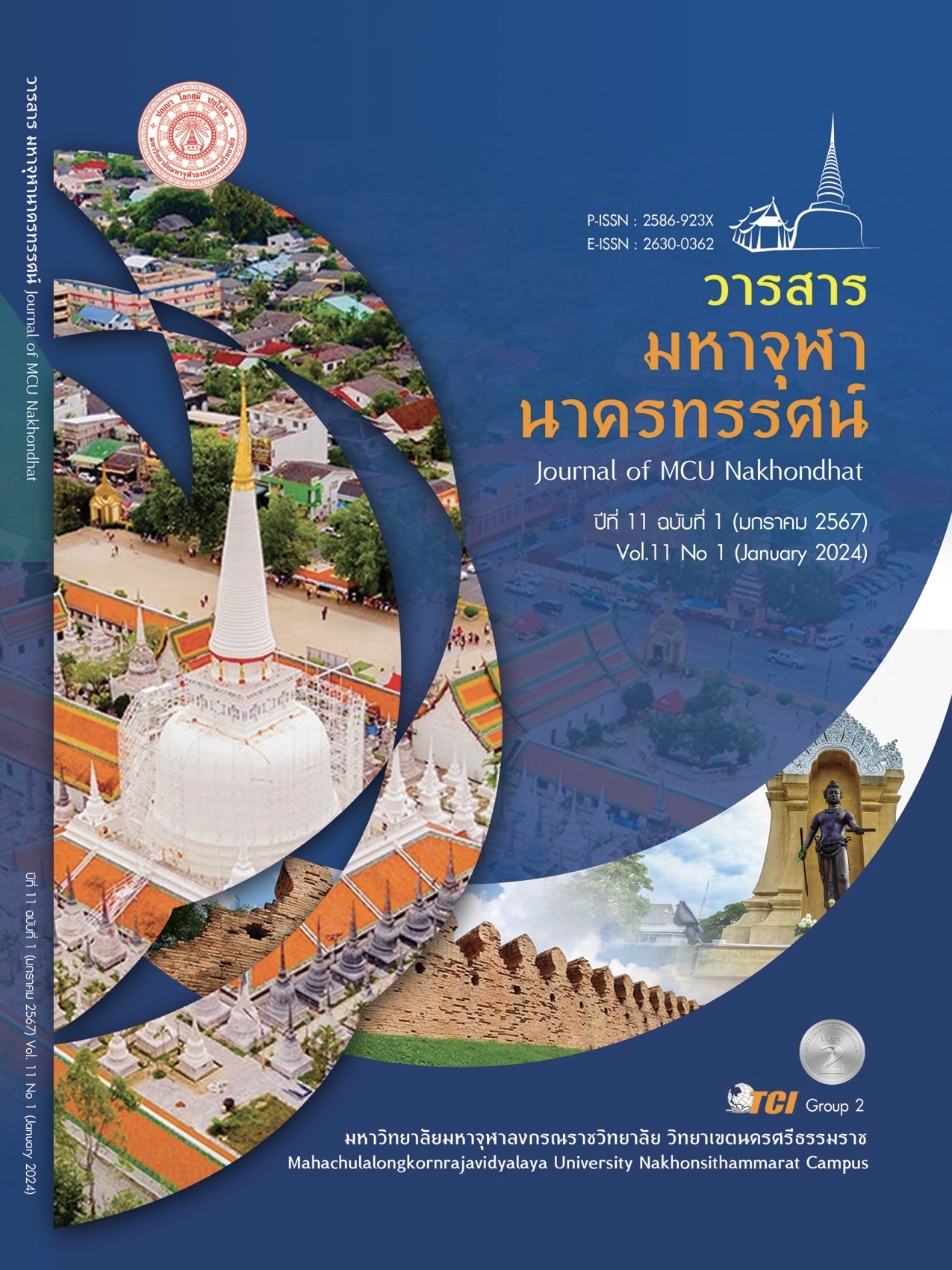นวัตกรรมสื่อสังคมออนไลน์เพื่อเผยแผ่พระพุทธศาสนา
Main Article Content
บทคัดย่อ
บทความวิชาการ เรื่อง “นวัตกรรมสื่อสังคมออนไลน์เพื่อเผยแผ่พระพุทธศาสนา” นี้มีวัตถุประสงค์เพื่อศึกษาแนวคิดทฤษฎีนวัตกรรมของสื่อสังคมออนไลน์เพื่อเผยแผ่พระพุทธศาสนากับนวัตกรรมสื่อสังคมออนไลน์และเพื่อเผยแผ่พระพุทธศาสนาของพระสงฆ์ในสังคมปัจจุบัน จึงควรให้ความสำคัญกับการเปลี่ยนแปลงอย่างรวดเร็วเพราะปัจจุบัน เป็นสังคมยุคใหม่ที่มีอิสระเสรีในการรับข้อมูลข่าวสาร การศึกษาเรื่องพระพุทธศาสนานั้นเป็นเรื่องง่าย และยังเอื้ออำนวยให้แก่ประชาชนทั่วไป เพราะไม่จำเป็นต้องเดินทางไปสืบค้นข้อมูลตามสถานที่ต่าง ๆ เพื่อหาความรู้ เกี่ยวกับพระพุทธศาสนาเพียงแต่มีโทรศัพท์มือถือหรือคอมพิวเตอร์ก็สามารถสืบค้นข้อมูลได้ด้วยตนเอง เช่นเดียวกับ พระสงฆ์ในยุคปัจจุบันต้องมีการปรับตัวให้เข้ากับยุคสมัยใหม่ เพราะสื่อสังคมออนไลน์ไม่ได้มีประโยชน์เพียงแค่สืบค้นข้อมูลแต่ยังสามารถนำมาประยุกต์ใช้ในหมู่พระสงฆ์ได้ ผ่านแอพพลิเคชั่นไม่ว่าจะเป็น Line Google Meet หรือ Zoom และยังแสดงธรรมะผ่านช่องทาง Facebook YouTube สามารถเผยแผ่ให้ผู้คนทั่วโลกได้รู้ถึงหลักคำสอน ของพระพุทธเจ้า หากการใช้ประโยชน์จากสื่อสังคมออนไลน์เหล่านี้พึงพินิจและพิจารณาให้สำรวมในอิริยาบถของพระสงฆ์เพื่อเป็นแบบอย่างให้สาธุชน ซึ่งด้านการเผยแผ่พระพุทธศาสนาของพระสงฆ์จึงต้องศึกษาสภาพสังคมปัจจุบัน เพื่อพัฒนาหลักการ วิธีการศึกษาและปรับปรุงรูปแบบและทักษะการใช้เทคโนโลยีในการเผยแผ่พระพุทธศาสนาให้ทันกับการเปลี่ยนแปลงของสังคม รูปแบบการสื่อสารพุทธธรรมต้องมีความเชื่อมโยงเกี่ยวกับองค์ประกอบของกระบวนการสื่อสาร เพราะรูปแบบจะสมบูรณ์หรือไม่นั้นขึ้นอยู่กับ ผู้ส่งสาร สาร ช่องทางและผู้รับสาร เพื่อให้การเผยแผ่ พระพุทธศาสนาของพระสงฆ์มีศักยภาพและประสิทธิภาพมากยิ่งขึ้นและนำเอาหลักการทางพุทธธรรมที่จะได้นำไปใช้ในการสร้างสรรค์ และประยุกต์ใช้ได้ต่อไป
Article Details

อนุญาตภายใต้เงื่อนไข Creative Commons Attribution-NonCommercial-NoDerivatives 4.0 International License.
เอกสารอ้างอิง
ธันยพัชร์ ขำเลิศ. (2566). การเผยแผ่พระพุทธศาสนาผ่านสื่อสังคมออนไลน์. เรียกใช้เมื่อ 28 กันยายน 2566 จาก https://tonkit360.com/94 885?fbclid=Iw AR1fla12GlkiTG _Z4s_s_FVJkamU18n3cHQfZuKRU 3q3ngKkvvnAT5fzo4U
บริษัทฟอร์ทูเดย์. (2566). การใช้สื่อสังคมออนไลน์ของประชาชนในแต่ละรุ่น. เรียกใช้เมื่อ 3 กันยายน 2566 จาก https://www.foretoday.asia/articles/generationgap/
พจนารถ สุพรรณกุล. (2565). การเผยแผ่พระพุทธศาสนากับเทคโนโลยีสารสนเทศ. เรียกใช้เมื่อ 27 กันยายน 2566 จาก https://phd.mbu.ac.th/index.php/2014-08-28-08-57-4/106-2014-09-2008-27-56
พระครูสังฆรักษ์พิทยา ญาณธโร (ปิยวรากุล). (2561). ศึกษาการเผยแผ่พระพุทธศาสนาในยุคดิจิทัล. ใน วิทยานิพนธ์พุทธศาสตรมหาบัณฑิต สาขาวิชาพระพุทธศาสนา. มหาวิทยาลัยมหาจุฬาลงกรณราชวิทยาลัย.
พระพรหมคุณาภรณ์ (ป.อ.ปยุตโต). (2548). พุทธวิธีการบริหาร. (พิมพ์ครั้งที่ 2). กรุงเทพมหานคร: บริษัทสหธรรมิกจำกัด.
พระพรหมคุณาภรณ์ (ป.อ.ปยุตโต). (2551). พจนานุกรมพุทธศาสน์ฉบับประมวลธรรม. กรุงเทพมหานคร: บริษัท เอส.อาร์.พริ้นติ้ง แมสโปรดักส์จำกัด.
พระมหาสมชาย ฐานวุุฑโต. (2549). วิธีการเผยแผ่พระพุทธศาสนาสมัยพุธกาล, ลมหายใจเข้าออกของพระพุทธศาสนา. กรุงเทพมหานคร: บริษัทพีวีพีซัพพลายส์จำกัด.
พระอนันต์์ อภินนฺโท (ผากา). (2549). แนวทางการใช้สื่อสังคมออนไลน์เพื่อเผยแผ่พระพุทธศานาของพระสงฆ์ในสังคมปัจจุบัน. วารสารพุทธศาสตร์ศึกษา, 13(2),61-79.
มหาจุฬาลงกรณราชวิทยาลัย. (2539). พระไตรปิฎกฉบับภาษาไทย ฉบับมหาจุฬาลงกรณราชวิทยาลัย. กรุงเทพมหานคร: โรงพิมพ์มหาจุฬาลงกรณราชวิทยาลัย.
สมศักดิ์ บุญปู่. (2558). การพัฒนาคณะสงฆ์ไทย. เรียกใช้เมื่อ 20 กันยายน 2566 จาก https://www.mcu .ac.th/article/detail/14295
เสถียร พันธรังษี. (2516). ศาสนาเปรียบเทียบ (พิมพ์ครั้งที่ 3). กรุงเทพมหานคร: ผดุงวิทยาการพิมพ์.


